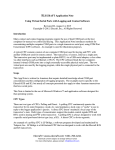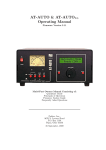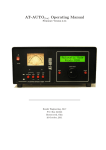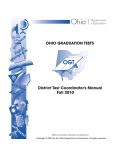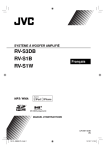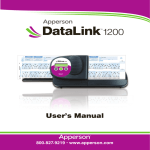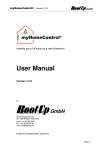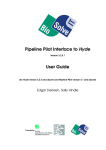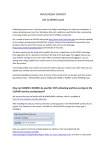Download 2.6.16 The Network Status Window
Transcript
2.6.16 The Network Status Window
2.6.16 The Network Status Window
o 1. Tabs
1.1. The Stations Tab
1.1.1. Right-Click Menu
1.1.2. What, Another Right-Click Menu?
1.1.2.1. Adjusting the Stations Tab's Format
1.2. The Resynchronize tab
1.3. The Rescore tab
1.4. The Options tab
1.5. The Actions Tab
1.6. The Messages Tab
1.7. Recovering from a Broken Logging Computer
The Network Status Window is brand new in N1MM Logger+. All network-related
options and actions have been moved to this new Window, with some minor
exceptions for backward compatibility reasons. Those remain in the Info window.
The new network scheme also simplifies and automates the network setup. So long
as each computer on the network is running the same version of N1MM Logger, and
the same contest and multi-operator class in the Contest Setup, the network will be
set up automatically.
×
Turning on Networked Computer Mode
If you open the Network Status window without enabling networking, you will see a
framed warning: "Networked Computer Mode is off - Click here to turn on." This
function replaces the Networked Computer Mode option that used to be on the entry
window's Config menu.
Do as it says and the other computer(s) in the network will appear.
1. Tabs
Whenever you open the Network Status window, it comes up in the Stations tab.
1.1. The Stations Tab
As you can see above, this tab contains all the basic information about each station
in the network:
Computer - This is the name assigned by Windows
IP Address - on the local area network
Pass - The pass frequency (to which other stations on the network can pass
new mults). Each station can set or change this frequency for itself manually
(on the Actions tab) and all stations can then see the new frequency.
Run - Whether each station is in Run or S&P mode
10/100 - What its current QSO rate is (last 10 and last 100 QSOs)
Freq - What frequency it is currently on.
Op - Who is operating (as set by OPON or Ctrl+O)
Msg - What, if anything, that station has just done, such as pressing a function
key
Send/Receive - normally reads "OK" unless there is a problem with the
network.
Master - Permits checking to select one station on the network as the master.
Check one to determine which connects to the Internet for cluster spots and
time synchronization.
A (((*))) in the title bar of the Network Status window means that your computerjust
broadcasted its IP address, usually in the process of establishing a connection to the
network. When connection is established, the title bar will reflect the number of
stations in the network.
The red highlight on the Messages tab means that there is a network message
waiting there that has not yet been read. In most cases, it is normal administrative
traffic, such as a connect request from another station on the network. The red
highlight may also be seen on the computer name during the connection process,
usually accompanied by a red highlight in the Send or Receive column. These will
disappear when a good connection is established.
×
Keeping Computer Clocks in Sync
In order to keep all of the clocks on a network in sync, all "slaves" - computers other
than the one designated as "master" - must be run as Administrator (by right-clicking
on the desktop icon and selecting "Run as administrator" from the pop-up menu), and
the master must be set up to sync with Internet time (at Date/Time in Control Panel).
1.1.1. Right-Click Menu
The right-click menu on the Stations tab opens a menu of powerful functions that
most multi-op operators will find important in real time. The rationale for placing it
here is that most operators will keep this tab on-screen, since it contains so much
important operational information. Each of these functions requires right-clicking
on the line entry of a computer other than the current one, to identify the
affected computer and open the right-click menu.
Pass current/last QSO - If you right-click on a computer to which you wish to
pass your current or last QSO (assuming that the station just worked has
agreed to QSY), and then click this option, a Talk message will be sent to the
Info window of the target computer, telling the other operator who to expect
and on what frequency. If that computer's Pass Frequency is set to zero, then
the Message will show the receiving computer's frequency at that time.
Talk - A right-click on any computer in the network, followed by a click on this
option, will open the Talk sub-window with that computer's name already
entered.Talk messages appear in the Info window of the receiving
computer.
Show connection log - Right-click on a computer and then on this option,
and a log of communications events between your computer and the one
selected will be displayed as an aid to trouble-shooting.
Target for call stacking - The intended use of this feature is for large multiops that have more than one radio on a given band, to permit the "helper"
operator to identify and queue stations for the run operator to work. If the two
computers are on the same frequency (+/- a small tolerance), a right-click on
the target computer turns on call stacking. Thereafter, any callsign that the
"helper" op enters in his Entry window will appear in the call-frame of the
target computer's Entry window. The run operator only needs to hit [Space] to
pull the call down into the call-sign textbox, ready to work. There is a
checkbox on the Options tab which, if selected, will clear the sending
computer's Entry window if the target computer works the station that
has been stacked.
Close and Open connection - These options are used to open and close
connections between the current computer and the one you right-clicked on.
Prevent automatic reconnect attempts - used when trouble-shooting the
network to stop the selected computer from sending reconnect requests every
thirty seconds.
Set station as master for telnet and time sync - Another way to set any
given computer on the network as the Master for receiving DX cluster spots
and performing time synchronization. Note that time synchronization requires
that N1MM Logger+ be run as Administrator on the receiving computer(s).
Auto-set column widths - used to adjust the format of the Stations display to
the minimum required to display the information currently present on-screen
Call for Help - Sends an audio request for assistance to the computer you
clicked on, together with a text message in the receiving computer's Info
window.
Stop Networking (not recommended during contest) - self-explanatory.
Help - when Internet access is available, displays the appropriate section in
the User Manual.
1.1.2. What, Another Right-Click Menu?
There is a second right-click menu associated with this tab. It is made visible when
you right-clink on the column headings row of the tab ("Computer", "IP Address", etc.)
. It allows you to select which columns on the Stations tab you want to display, in the
event that you want to minimize required screen space while still monitoring network
activity.
1.1.2.1. Adjusting the Stations Tab's Format
If you put your cursor between column headings in that row and move it rightward
almost to the next column to the right, you'll see that it changes to a standard
Windows "change width" character (a vertical line with horizontal arrows facing away
from it). You can drag that marker right to increase the width of the column to its left,
or left to decrease the width of that column.
It is possible using this control to make the heading of a column disappear altogether.
If you do that and want to recover, right-click in the body of the tab, and select "AutoSet Column Widths" to get back to the full set of minimum-width headings.
You can also reorder the columns, by clicking on a column heading itself and
dragging it where you want it. Be a little cautious in doing this, though, because there
is no command for automatically restoring column order to the original - you'll have to
do that manually.
1.2. The Resynchronize tab
Normally every computer has a copy of every QSO in the log. If all computers stay
connected at all times, new QSOs entered on one computer are broadcast to the
other computers in the network so that every computer always has a complete copy
of the log.
If it is necessary to edit or delete a QSO, the computer that the QSO was initially
logged from must be used to perform the change. Other computers do not have
permission to change the QSO. Any such change made at the originating computer
will be reflected on all computers that are connected to the network at the time the
change is made.
If a computer becomes disconnected from the network, you can continue to log
contacts on it. When the computer rejoins the network, all QSOs made on that
computer will automatically be sent to the other computers, and all new QSOs made
on the other computers will be copied to the rejoining computer. This process is
called resynchronization (resync for short).
Resynchronization of newly added QSOs is automatic. However, if changes (edits or
deletions) are made to previously existing QSOs while a computer is disconnected
from the network, those changes will not be applied during the automatic resync
process. In other words, the automatic resync when a computer reconnects to the
network only updates new QSOs; it does not update QSOs that were already in the
log. Because of this, it is a good idea to perform an additional manual resync at the
end of the contest in order to ensure that all the logs are identical, and that is the
purpose of this tab.
A manual resync operation initiated from this tab requests each other computer in the
network to update the requesting station's copies of all QSOs that were originally
logged at the other computer in order to take into account the effects of any changes
(edits or deletions) that were made during network outages.
The "Contest" button will resynchronize from the start of the contest.
The "Last" button and the textbox next to it are used to resync for a shorter
period when you know when the problem occurred.
The "Since" button works the same way but by resync start date and time
rather than duration.
The "Resync All Stations" checkbox syncs each log with all others
simultaneously. Use this after the contest is over to ensure that all logs are
identical. This can be a resource-intensive process; in order to avoid disrupting
operations at other computers, do not use it during the contest while any
computers are still being used to log new contacts.
The "Rescore When Done" checkbox rescores the contest after the resync is
complete on this computer, or all computers if Resync All is selected
1.3. The Rescore tab
This tab controls rescoring the log on the local computer, recalculating QSO points
and multipliers, in order to take into account the effects of any changes (edits or
deletions) on the final score. This is recommended practice at the end of a contest,
before a Cabrillo file is generated for sending to the contest sponsor. The buttons are
the same as those on the left-hand side of the Resynchronize tab, and are used
similarly .
1.4. The Options tab
Left to right and top to bottom, following is a description of the radio buttons and
checkboxes on this tab.
Run1/Run2 radio buttons - these buttons are greyed out except in the case
of the Multi-2 class, in which case you can click the radio button to designate
the current computer as Run 1 or 2.
Don't work non-mults - check this box if you are entered in the multi-single
class in contests where the current computer must not work non-multipliers.
When checked, will block the station from working non-mults. Function key
messages will not be sent to a non-mult.
Don't automatically change to S&P mode - When checked, prevents the
current computer from switching from Run to S&P mode when QSYing by
more than the tuning tolerance for its mode. See this page for more details on
per-mode tuning tolerance.
Wipe callsign when logged by stack target - Use in conjunction with call
stacking. If you stack a callsign for your partner to work, and he works it, your
call-sign textbox will automatically be cleared so you can stack another.
Trace Networked Computer messages - a trouble-shooting tool that logs
messages between computers on the network to a file titled
MultiUserMessages.txt
Force ALL other stations to stop transmitting when I transmit - selfexplanatory
Block my Tx only if other station transmitting on the same band and
mode (multi-one) - self-explanatory
1.5. The Actions Tab
Talk (Ctl+E) - opens a sub-window, in which you can send or receive talk
messages to/from the other station(s) on the network.
The first of these two illustrations is an empty Talk window. By default, Talk
messages are sent to all stations, denoted by the asterisk. If you enter a computer
name in place of the asterisk, followed by a space and the text of a message, the
message will be sent only to that station. That computer name then becomes the
default address for Talk messages from you until replaced. Note: you must enter the
computer name exactly as shown in the left-most column of the Stations tab, except
that whatever case you enter will be changed to all upper-case to conform with the
Microsoft standard.
The upper pane is now where talk messages are received, as in the second
illustration. Messages in red have been received, and are also displayed in the
bottom pane of the Info window, Ctrl+E can now be used to toggle the Talk window
between full size and minimized to the lower left corner of your screen.
The first time you receive a Talk message while the Talk window is open but
minimized, you will notice a new icon in the right-hand end of the Windows taskbar,
with a message balloon above it. The icon will remain there until the Talk window is
closed. This is in addition to the N1MM+ logo you will see over to the left, which is
present any time the program is open. Thereafter, each time a new talk message
comes in while the Talk window is minimized, a message balloon will appear above
the new icon, as illustrated below. The message balloon is displayed for 5 seconds
and then disappears.
If you want to send a message only to a particular station, right-clicking on that
station's line on the Stations tab and then selecting "Talk" will relieve you of having to
fill in the computer name. Other operation is as above.
Set Your Pass Frequency - enter the frequency you want other stations on
the network to pass stations to. It will appear on all stations' Stations tab.
Stop Networking - Self explanatory - strongly discouraged during a contest.
Force Time Sync - Self-explanatory
Edit Computer Addresses - N1MM Logger+ networking is automatic within a
single subnet, which is usually the case in local area networks. However, if
you want to network across a Wide Area Network, or in rare instances where
your network involves more than one subnet, auto-configuration will not work.
In that case you will need to fill in computer addresses in this table exactly as
assigned by the network(s). For WAN networking you must enter the
external IP addresses of each LAN and also port numbers for all the
computers you wish to connect to, in the format XX.XXX.XX.XX:port number}.
The port number is needed to permit operators to set up forwarding through
their router firewalls to the right computer. If going subnet-to-subnet, you do
not need to enter port numbers and the IP addresses would be the internal IP
address. Here's an example in the WAN case, such as would be needed for a
distributed IARU HQ "station":
o
You'll note that the first computer listed has no port number - this is
because 12070 is the N1MM+ networking port for all computers on any
LAN. The port numbers on the others are ones you assign, for use only
in port forwarding.
o
Please refer to your router help file for instructions on setting up port
forwarding.
Reset Serial Numbers at All Stations - only for use when you have screwed
up. Sets the serial numbers on all computers to the highest value in any of the
logs, plus 1, so you can start a new serial number sequence without duplicate
numbers. This does not change the serial numbers of QSOs that are already
logged.
1.6. The Messages Tab
Displays networking messages
1.7. Recovering from a Broken Logging Computer
What do you do if one of your computers no longer works?
DO NOT ADD ANOTHER COMPUTER WITH THE SAME NAME!
If you do not replace it on the network
1. Each computer will have a copy of the QSOs logged by the broken computer.
If they all agree on the number of QSOs, then you should be fine. If not, you
will need to compare the lists from each one and determine which QSOs are
missing.
If you replace it on the network
1. Locate a running network computer whose log includes the QSOs from the
broken logging computer. SHUT THE PROGRAM DOWN on this computer.
2. Copy that computer’s <log>.S3DB. <log>.s3db-wal and <log>.s3db-shm
database files (The last two are temporary files that usually do not exist) to a
network drive, diskette or flash drive.
3. Copy the <log>.S3DB* database files from the temporary medium to the
replacement computer’s \database directory
4. Configure the replacement computer and N1MM Logger and begin logging.
Any new QSOs will be identified by the replacement computer's name, which
MUST not be the same as the broken machine.
5. Restart the source computer and resume logging
Notes:
Each computer is the "book of record" for the QSOs logged on that computer,
even though all QSOs are normally logged on every computer, for redundancy.
Resync simply compares what your log shows for QSOs by a particular computer to
what that computer has. If there is a difference, the computer that logged the QSO
sends the updated QSOs to the requesting computer.
The best way to avoid all this is to keep a spare computer up and running
N1MM+ on the network. You can then just swap it in for the broken one.
http://n1mm.hamdocs.com/tiki-index.php?page=Network+Status+Window













